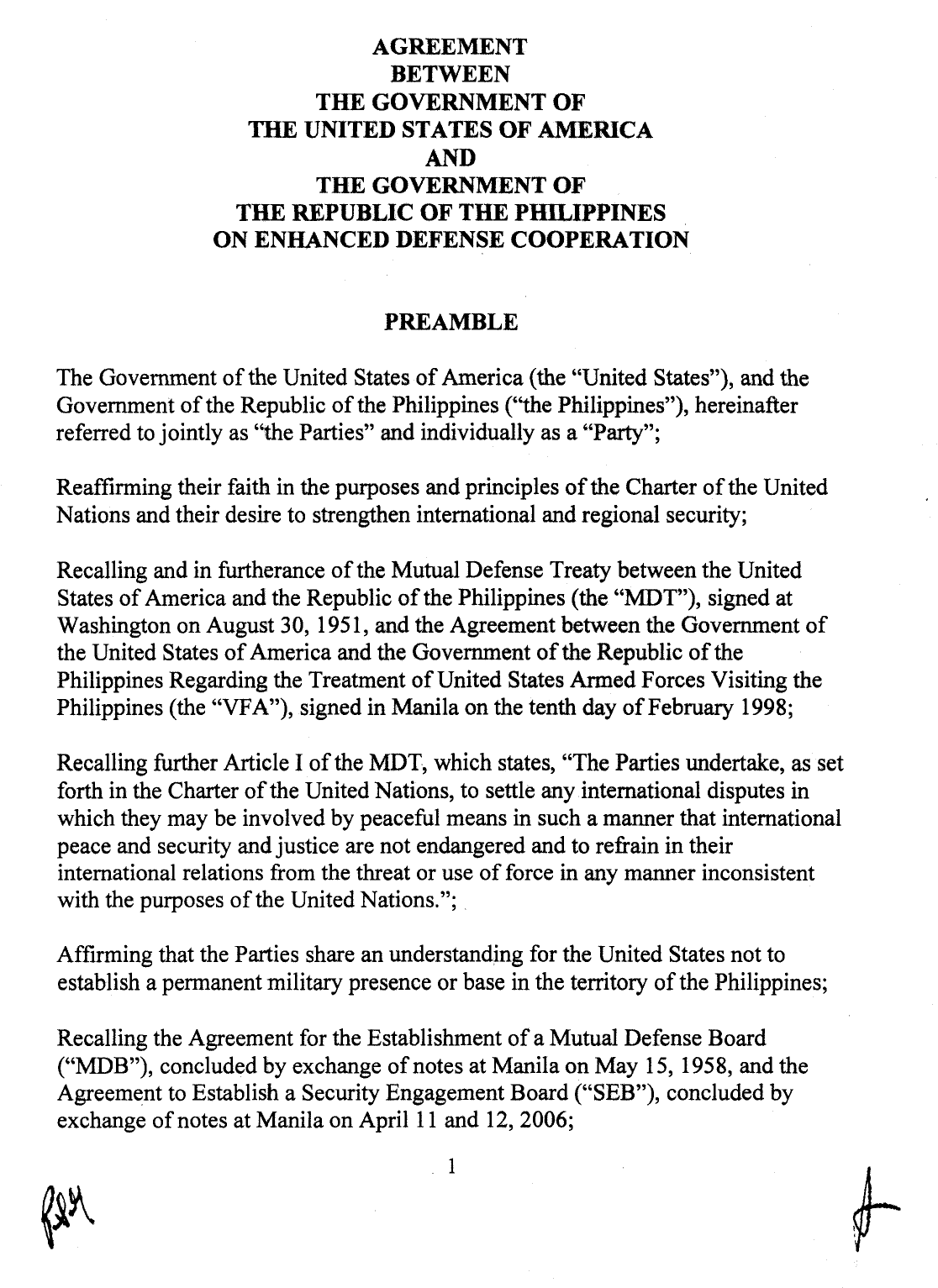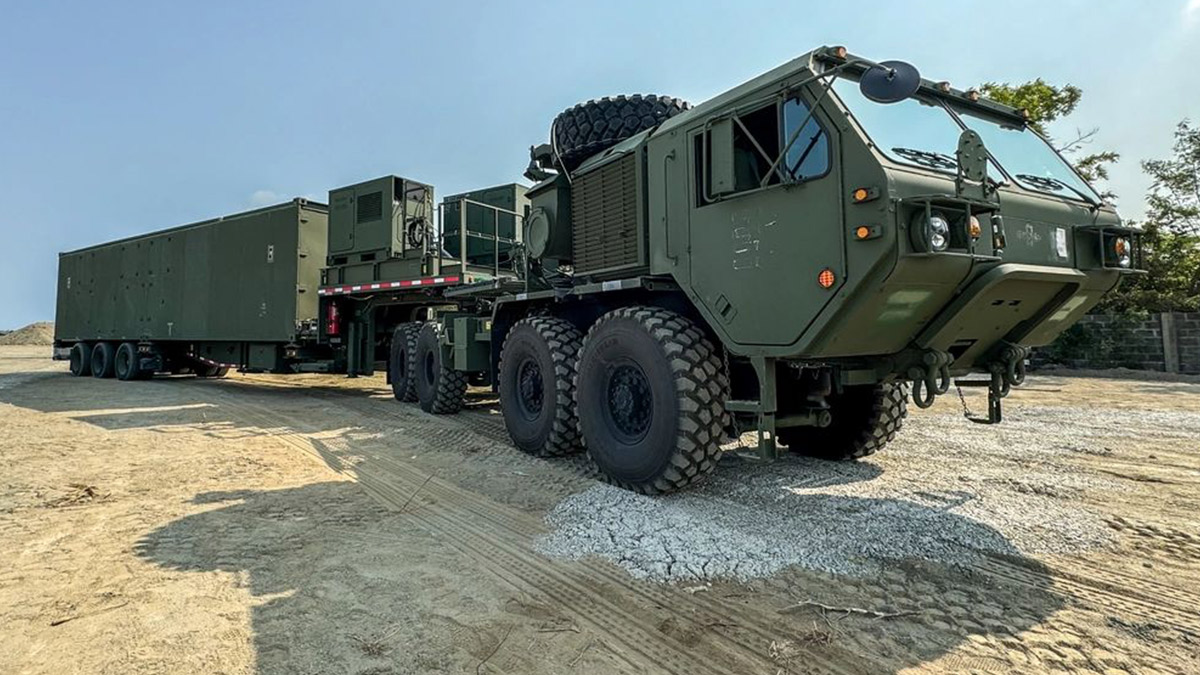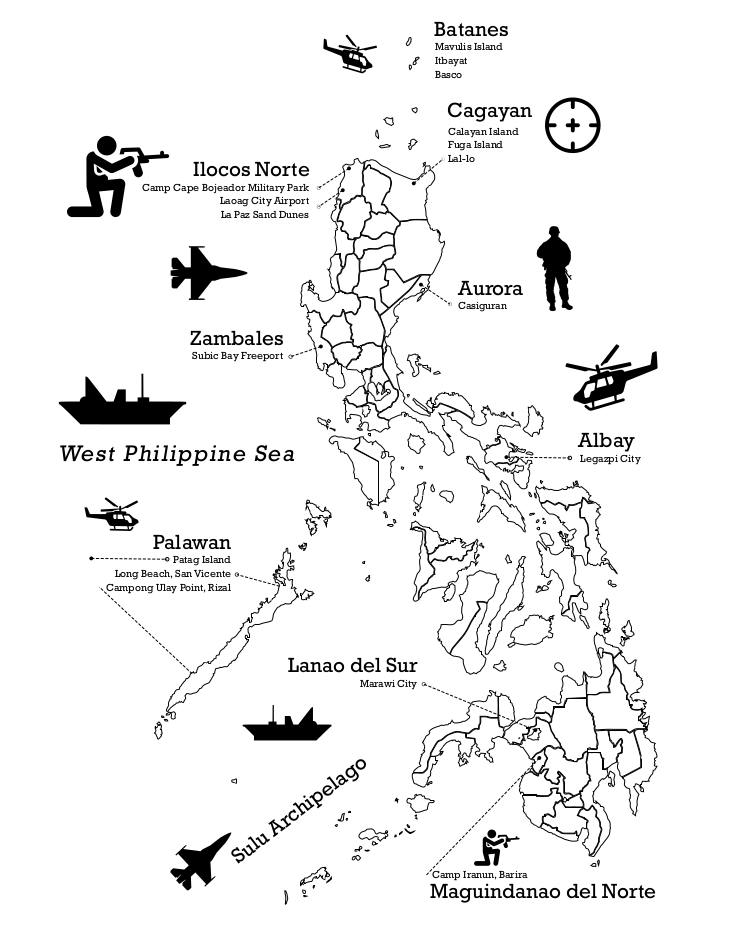Download here: PDF
The outright re-establishment of US military bases in the country and its relentless and escalating war games on land, sea, and air are flagrant manifestations of US imperialist domination of the Philippines. This further tightens the grip of US imperialism on the Philippine neocolonial state, especially on the puppet Armed Forces of the Philippines (AFP).
This year marks a decade of the Enhanced Defense Cooperation Agreement (EDCA), a treaty that allowed the re-establishment of US military bases in the country. Like the earlier lopsided Military Bases Agreement, it gives the US military forces the freedom to build bases and facilities in the Philippines to station troops and store arms and war matériel.
In 10 years under EDCA, the US has built at least nine military bases, each one blatantly trampling on the country’s sovereignty. These bases are a testament to the fact that the country is not truly free and has no independent foreign policy. They bring social injustice and harm. These military bases are also the biggest launching pads for war games that devastate and endanger the Filipino people.

1) What is EDCA?
EDCA is a defense agreement between the US and Philippine governments, a supplement to the Mutual Defense Treaty (MDT) and the PH-US Visiting Forces Agreement (VFA). It was signed by then Philippine Defense Secretary Voltaire Gazmin and US Ambassador to the Philippines Philip Goldberg in Manila on April 28, 2014. The Aquino II regime then gifted the signed treaty to former US President Barack Obama during the latter’s visit to the country.
The agreement has an initial effectivity of 10 years, which will automatically be renewed unless terminated by either party. Negotiations over EDCA began in August 2013 and went through eight rounds of talks. The agreement was originally named Increased Rotational Presence Framework Agreement or the increase in “visits” of US troops under the VFA. This framework was deemed too narrow by the US imperialists, which sought to expand it to allow for a more permanent presence of its troops in the country.
The Philippines and the US considered the agreement an “executive agreement” and not a formal treaty. This tactic was used by both governments to circumvent the requirement for their respective senates to pass and ratify the agreement.
The EDCA allowed US military bases in the Philippines where the government has absolutely no control over the activities of US soldiers.

2) How many “EDCA sites” or US military bases are in the Philippines?
Article III, Section 1 of the agreement stipulates that US forces are allowed to conduct “training; transit; support and related activities; refuelling of aircraft; bunkering of vessels; temporary maintenance of vehicles, vessels and aircraft; temporary accommodation of personnel; communications; prepositioning of equipment, supplies and materiel; deploying forces and materiel; and other such activites as the Parties may agree.” The US may also build facilities needed to house its troops and their weapons and matériel.
There are presently nine declared “EDCA sites” or US military bases in the Philippines. The Mutual Defense Board-Security Engagement Board (MDB-SEB) initially approved five bases on March 19, 2016. These include Cesar Basa Air Base in Floridablanca, Pampanga; Fort Magsaysay Military Reservation in Nueva Ecija; Lumbia Airport in Cagayan De Oro; Antonio Bautista Airbase in Puerto Princesa, Palawan; and Benito Ebuen Air Base in Cebu.
The MDB-SEB augmented the list of “EDCA sites” in February 2023 on the pretext of “preparing” for the “China threat.” These include Naval Base Camilo Osias in Santa Ana, Cagayan; Lal-lo Airport in Lal-lo, Cagayan; Camp Melchor Dela Cruz in Gamu, Isabela; and Balabac Island in Palawan.
Upon the request of the US, any public or private land in the country can be “agreed upon” to become an “EDCA site.” Thus, the entire Philippines will serve as a large military base for imperialist US. The transformation of the country into a military base is an extension of its bases in South Korea and Japan.
The US government reported that its Department of Defense allocated $109 million for infrastructure projects in “EDCA sites” over the past decade. The largest chunk was allocated for developing the Basa Air Base “EDCA site”, spending over $59 million on a warehouse, command and control infrastructure, fuel storage, and aircraft parking.
For 2025, the Biden regime allocated $128 million for 36 new projects in these EDCA sites. The imperialist US may charge the cost of its construction of the facilities or infrastructure to the Philippine government based on “consultation” when the US troops leave, contrary to their supposed automatic Philippine ownership. This is on top of the expenses incurred by the Philippine government using the funds of the Filipino people.

3) Why are there US soldiers and armament outside “EDCA sites”?
The EDCA allows the US to use any road, airport, and seaport and other civilian facilities, anywhere in the Philippines. Article III, Section 2 states that “when requested, the Designated Authority of the Philippines shall assist in facilitating transit or temporary access by United States forces to public land and facilities (including roads, ports and airfields), including those owned or controlled by local governments, and to other land and facilities.” The term “temporary” is now being used to allow US forces to use even areas not listed as official “EDCA sites.”
At least eight undeclared or secret US military bases in the Philippines where US troops and arms have long been stationed are now being disclosed. Reports indicate that infrastructure for US soldiers are being built in these places. In some areas, despite no official admission of US use, American troops, military vehicles, and weapons are frequently seen. The US is given access to these areas under the EDCA.
Some of these areas include:
Subic, Zambales
Among the unofficial “EDCA sites” is Subic Bay Freeport (SBF), formerly the largest US military base in Asia, now serving as a repair facility for US warships. Located here is the Subic Drydocks Corporation, wholly owned by Cabras Marine Corporation, which manages the US Navy’s dry dock facilities. In January-July 2024, the SDS repaired 30 US Navy ships. One of these was the USNS Millinocket, which was overhauled in Subic from January 29 to July 31, or for 183 days. The ocean surveillance vessel USNS Victorious was also repaired here for 85 days, and the USS Manchester for seven days.
Cerberus Capital Management LP owns other facilities in SBF besides dry docks. This company has widespread investments in US defense companies such as M1 Support Services for US Air Force fighter planes, military vehicles manufacturer Navistar Defense, and the mercenary training company Tier 1 Group.
Ilocos Norte
The US primarily uses the headquarters of the 4th Marine Brigade Landing Team in Camp Cape Bojeador Military Park in Barangay Bobon, Burgos, Ilocos Norte, for war games and arms storage. The headquarters was built in the barangay in 2022. It covers 30 hectares of land along the barangay coast and directly faces the South China Sea and Taiwan Strait. It has an 800-meter-long wall, which is 15 meters thick, four meters high and eight meters deep. The headquarters is believed to be used to monitor China’s movements on US direction.
Aside from this, the US Marine Corps uses as refuelling station the Laoag City Airport, the same airport where the US Army Pacific Command positioned the ground-based missile system Typhon Mid-Range Capability used in the Balikatan Exercises 2024. The US earlier announced that the system will be removed in September but continues to maintain it in the civilian airport without explanation. China and Russia have repeatedly warned against the presence of the missile system in the Philippines, the first and only one in Asia.

Cagayan Valley
In addition to the two “EDCA sites” in Cagayan, US troops stay in the region’s many towns.
In Batanes, the US built a “Humanitarian Assistance Disaster Response (HADR) warehouse” in the town of Itbayat. The warehouse was funded by the US and built with the help of AFP soldiers. The US 3rd Marine Expeditionary Forces and the Joint United States Military Advisory Group uses it for “HADR mission” after calamities. A detachment where US troops stay is also located in Mavulis Island, Itbayat. The pier in Basco was dredged to allow large US warships to dock.
In Cagayan, the US uses AFP facilities in Calayan Island, Calayan, and Fuga Island in Aparri. US soldiers also use other facilities in the town of Lal-lo, outside of Lal-lo Airport, which is an “EDCA site”.
Aurora
The civilian facility Aurora Pacific Economic Zone and Freeport Authority (APECO) in Casiguran, Aurora, is continuously being transformed into a facility for the US military and American defense companies. In 2019, the Duterte regime agreed with the US to construct a military port in Casiguran, supposedly for the Philippine Navy’s use. The project (Casiguran Port Construction Project) is worth ₱1.3 billion.
Concurrently, the US is involved in developing an airport within the economic zone. In 2020, the US was reportedly interested in building a drone base inside the facility as part of its efforts to strengthen its military presence in the region. The American company Newark was reportedly tapped to further “develop” the port in preparation for the entry of American defense companies into APECO.
The development of the port and airport aligns with the US plan to turn the 1,300-hectare economic zone into a “logistics hub.” In September, APECO was formally declared a “national defense hub” that can be used to position troops, matériel, and communication systems, and others. Department of National Defense (DND) Secretary Gilbert Teodoro also said that the AFP plans to build a military camp within the zone.
Catanduanes
In Catanduanes, reports indicate plans to build a naval base at the Long Range Navigation or Loran Station in the town of Bagamanoc. According to residents, they are certain the US soldiers will use it as a base for warships and weapons. Aside from posing as a threat to the country’s security, the construction of the naval base will also displace farmers and fishermen living in the area where the base will rise.
Many will also lose their livelihoods once US and Filipino soldiers use the abaca plantations, farms, coastlines, and seas to launch war games, military exercises, and other displays of force.
Marawi City
In Marawi City, community leaders are aware of the construction of a military base using EDCA funds in “ground zero,” but the government conceals this from the public. The leaders also revealed plans to build a special economic zone in the area.

4) Does the Philippines have control over “EDCA sites”?
The Philippine government has no control over the “EDCA sites.” Contrary to public pronouncements that the areas will remain under Philippine authority, the EDCA states that it is the prerogative of the US military whether Philippine government officials will be allowed access to the areas, in line with “operational safety and security requirements” (Article III, Section 5).
Furthermore, the Philippines will not be given the chance to use the facilities and equipment the US will bring into the “EDCA site”. Article IV, Section 3 defined that “the prepositioned matériel of the US shall be for the exclusive use of United States forces.”
Moreover, the US is totally free to bring in nuclear arms into the military bases. Contrary to the EDCA’s provision that weapons prepostioned by the US do not include nuclear arms (Article IV, Section 6), the Philippine government has no power to ensure US military compliance. In fact, Article IV, Section 4 states that US forces and contractors shall be “granted unimpeded access to the Agreed Locations for all matters relating to the prepositioning and storage of defense equipment, supplies, and materiel.” Under the MBA, the US is believed to have stationed nuclear arms in the Philippines without disclosing their number and location, and without inquiry from past governments.
On top of the Philippines having no control over the military base, the EDCA also grants the US special privileges and treats it as a sovereign power with extraterritorial rights. Article VII, Section 1 states that US forces may use electricity, water, and other utilities and pay the same fees as the Philippine government, without paying taxes. Similarly, Article VII, Section 2 states that “the US is authorized to operate its own telecommunications system” and “the use of the radio spectrum shall be free of cost to the US.”
5) Military infrastructure for expanding and permanent presence
The EDCA was signed within the context of the US’s “pivot to Asia” to counter the growing power of its imperialist rival China. Under this “pivot”, the US shifted 60% of its naval forces to the region. The expansion of this presence required additional ports, airports, barracks, and other facilities. The return of US troops to its former bases and the opening of new ones form part of this “pivot.”
The EDCA is an instrument for the large-scale and long-term deployment of US troops in the region, which remains in the country alongside war games and other military activities. US soldiers freely use AFP facilities and “EDCA sites” for these exercises, to the detriment of Filipinos. These activities are determined by the Mutual Defense Board and Security Engagement Board (MDB-SEB).
In 2018, the MDB-SEB reported staging 261 joint activities between the US and the Philippines in the country. This increased to 281 in 2019, over 300 in 2020, and increased further in 2022 to over 400 activities. It surged to over 500 in 2023 and is expected to be even higher in 2024.
The increasing number of participants in the Balikatan war games—the main war games between the US and the Philippines in the country—also clearly illustrates the expanding US military presence and that of its allied foreign countries in the Philippines. In 2014, almost 2,500 US troops participated in Balikatan. This increased to 5,000 in 2016 and scheduled the participation of 6,500 US soldiers in 2020, which was, however, cancelled due to the pandemic. Even during the peak of the COVID-19 pandemic, Balikatan was held with a limited number of 225 US troops.
In 2022, over 5,100 US soldiers participated in the exercise. They used 50 fighter planes, four warships, 10 amphibious vessels, four HIMARS rocket system launchers, and four Patriot missile systems. The exercise also included 40 Australian Defense Force personnel.
The Balikatan 39-24 this year is considered the largest in history, with almost 16,000 soldiers participating, including 11,000 US soldiers and 5,000 Filipino troopers, and soldiers from Australia and France. Representatives from 14 other foreign countries also entered the country to participate and observe.
For the first time, the US together with the French naval force brought Balikatan outside the Philippines’ territorial waters. Prior to this, the US conducted a “historic” naval maneuver with the Philippines, Australia, and Japan. The US also “historically” positioned its new Typhon Missile System (TMS) in the country and Asia, consisting of four missile launchers capable of launching missiles up to a distance of 1,600 kilometers.
The US also conducted new war games in the past decade, including Cope Thunder and Maritime Cooperative Activity (MCA) in the West Philippine Sea. The US launched two series of aerial war games, Cope Thunder, one in April and another in July.
Major war games from January to August 2024
From January to August this year, US military forces launched almost daily war games on Philippine land, air, and sea. Its allied military forces and its lackey Armed Forces of the Philippines (AFP) participated. There were war games during at least 105 of 244 days, with the longest and uninterrupted period from April 7 to June 21 (76 days). In total, at least 21,000 US troops, Australian, Canadian, Japanese, French, and other foreign troops participated in these exercises.
There were several instances where two to three war games took place simultaneously in the country. Through these exercises, US troops maintain permanent presence in the country.
Before and after the war games, foreign military officials held various meetings, preparations, and inspections in the areas where the activities took place. In eight months, US military officials held almost 20 high-level meetings with the AFP, Department of National Defense and Malacañang.

6) Filipino people’s opposition to EDCA
Since the signing of the EDCA, patriotic and democratic organizations have continuously conducted efforts to oppose and scrap the agreement. From legal battles, demonstrations, and international campaigns, the Filipino people’s resistance against EDCA continues to this day.
Less than a month after the agreement was signed, on May 26, 2014, patriotic former senators Rene Saguisag and Wigberto Tañada, along with leaders of the Bagong Alyansang Makabayan (Bayan) and other progressive groups, filed petitions with the Supreme Court to question the constitutionality of the EDCA. Senators Tañada and Saguisag, along with 10 other senators, voted in 1991 to expel US military bases from Subic Naval Base in Zambales and Clark Air Base in Pampanga. Other petitions were also filed against EDCA.
In its January 12, 2016 decision, the Supreme Court declared the EDCA constitutional. The decision became final on July 26, 2016, following the denial of the motion for reconsideration of the court’s earlier decision.
Despite this setback, national-democratic groups continue to lead protests and activities against EDCA, the VFA, and other unequal military agreements between the US and the Philippines.
These included fisherfolk’s protests against war games in the sea that imposed “fishing bans” resulting in the disruption of their livelihood. In Ilocos, the local government expressed concern over the use of their area for Balikatan without permission. Residents also complained about involving them in war games to simulate carrying wounded Americans.
The latest effort was the peace mission by Bayan-USA and Pilipinong Nagkakaisa para sa Soberanya (P1NAS) conducted in Central Luzon, Ilocos Norte, and Marawi City to investigate the “EDCA sites” and the venues of Balikatan 2024. The mission publicized its findings in June.
The delegation’s findings included the US stockpiling of suspected military equipment outside designated “EDCA sites” and the US soldiers’ exploitation of the resources of the Cagayan people; collusion between private companies and the military; not informing communities in Ilocos and Cagayan where Balikatan was held, bringing trauma and anxiety to the civilian population; and militarization, repression, and Red-tagging of communities defending their livelihood. In Marawi City, local officials narrated being misinformed about the construction of a military base and “economic zone” near “ground zero” using EDCA funds.
Scrap EDCA!
Abolish US military bases in the Philippines!
Prepared by:
Information Bureau
Communist Party of the Philippines
November 2024
